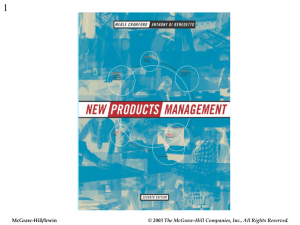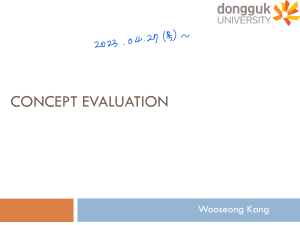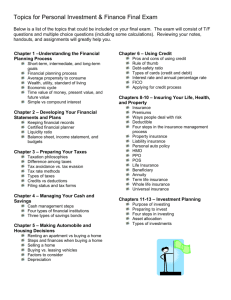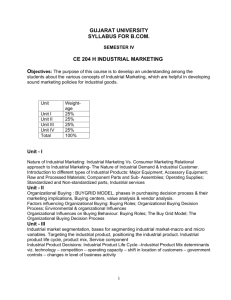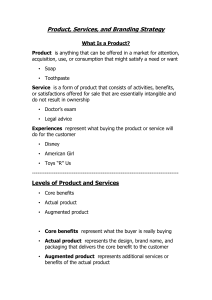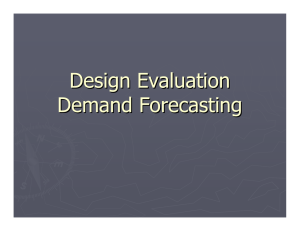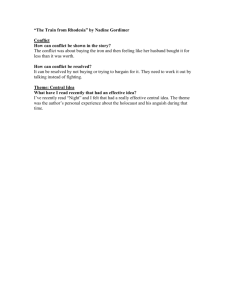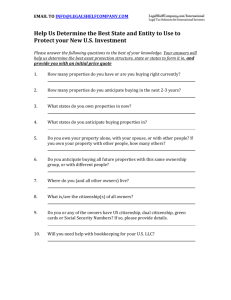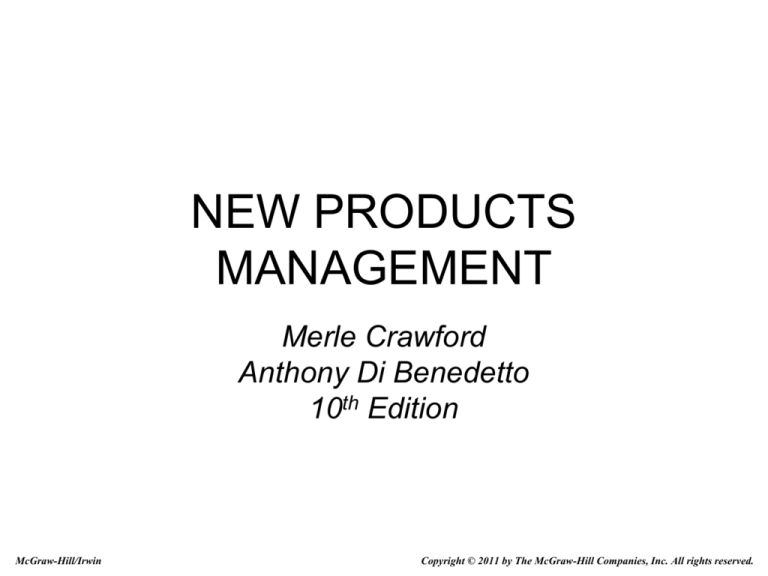
NEW PRODUCTS
MANAGEMENT
Merle Crawford
Anthony Di Benedetto
10th Edition
McGraw-Hill/Irwin
Copyright © 2011 by The McGraw-Hill Companies, Inc. All rights reserved.
PART THREE
CONCEPT/PROJECT EVALUATION
8-2
Concept/Project Evaluation
8-3
Chapter 08
The Concept Evaluation System
8-4
The Evaluation System
8-5
Cumulative Expenditures Curve
% of
expenditures
Many high-tech
products
Many consumer
products
Time
Launch8-6
Risk/Payoff Matrix at Each
Evaluation
Decision
A
Stop the Project Now
B
Continue to Next Evaluation
A. Product would fail if
marketed
AA
BA
B. Product would succeed if
marketed
AB
BB
• Cells AA and BB are “correct” decisions.
• Cells BA and AB are errors, but they have different
cost and probability dimensions.
• Usually BA (the “go” error) is much more costly – but
don’t forget opportunity costs!
• Consider how “new-to-the-world” the product is as
that has an impact on the risk level.
8-7
Planning the Evaluation
System: Four Concepts
• Rolling Evaluation (tentative nature of new
products process)
• Potholes
• People
• Surrogates
8-8
Rolling Evaluation (or,
"Everything is Tentative")
• Project is assessed continuously (rather than a single
Go/No Go decision)
• Financial analysis also needs to be built up continuously
• Not enough data early on for complex financial analyses
• Run risk of killing off too many good ideas early
• Marketing begins early in the process
• Key: new product participants avoid "good/bad"
mindsets, avoid premature closure
8-9
Potholes
Know what the really damaging problems
are for your firm and focus on them when
evaluating concepts.
Examples:
– Campbell Soup focuses on manufacturing
cost and taste.
– Drug companies focus on FDA approval.
– Software developers may focus on customer
unwillingness to learn how to use complex
software.
8-10
People
• Proposal may be hard to stop once there
is buy-in on the concept.
• Need tough demanding hurdles, especially
late in new products process.
• Personal risk associated with new product
development.
• Need system that protects developers and
offers reassurance (if warranted).
8-11
Surrogates
• Surrogate questions give clues to the
real answer.
Real Question
Will they prefer it?
Will cost be competitive?
Will competition leap in?
Will it sell?
Surrogate Question
Did they keep the prototype
product we gave them after
the concept test?
Does it match our
manufacturing skills?
What did they do last time?
Did it do well in field testing?
8-12
An A-T-A-R Model of Innovation
Diffusion
Profits = Units Sold x Profit Per Unit
Units Sold = Number of buying units
x % aware of product
x % who would try product if they can get it
x % to whom product is available
x repeat measure (what is the average number of units
bought per person per year, including repeats)
x Number of units repeaters buy in a year
Profit Per Unit = Revenue per unit - cost per unit
8-13
The A-T-A-R Model: Definitions
• Buying Unit: Purchase point (person or
department/buying center).
• Aware: Has heard about the new product with some
characteristic that differentiates it.
• Available: If the buyer wants to try the product, the effort
to find it will be successful (expressed as a percentage).
• Trial: Usually means a purchase or consumption of the
product.
• Repeat: The product is bought at least once more, or
(for durables) recommended to others.
8-14
A-T-A-R Model Application
10 million
x 40%
x 20%
x 70%
x 1.20
Number of owners of video cellphones
Percent awareness after one year
Percent of aware owners who will try product
Percent availability at electronics retailers
Measure of repeat (20% of customers buy a
second phone)
x $50
Price per unit minus trade margins and
discounts ($100) minus unit cost at the
intended volume ($50)
= $33,600,000 Profits
8-15
Points to Note About A-T-A-R Model
1. Each factor is subject to estimation.
Estimates improve with each step in the development
phase.
2. Inadequate profit forecast can be improved by
changing factors and doing a “what-if” analysis.
If profit forecast is inadequate, look at each factor and
see which can be improved, and at what cost.
In our example, could retail margins be increased to
increase distribution? Could more advertising spending
lead to more awareness?
Consider qualitative issues as well (advertising theme or
execution).
8-16
Key Definitions in A-T-A-R Model
• Buying unit: person, home, purchasing manager,
family, etc.
• Awareness: is the buying unit sufficiently
informed to stimulate trial (i.e., are they
knowledgeable enough?)
• Trial: can be actual in-home trial, on-site trial,
vicarious trial (triers share results with non-triers)
– depending on the product type.
– Usually requires some expense to get the trial
supply, and enough time to decide whether
the product was any good.
8-17
Key Definitions (continued)
• Availability: can the buyer easily get to the new
product?
– Can be percent of outlets carrying product, or
ACV (all commodity volume) which is the
percentage of the market that has access to
the product in local distribution channels.
• Repeat: is actually a measure of how successful
the trial was and how pleased the buying unit is.
– Can be the actual repeat rate, or a proxy
could be a statement of satisfaction level or
how likely the buying unit would recommend it
to others.
8-18

